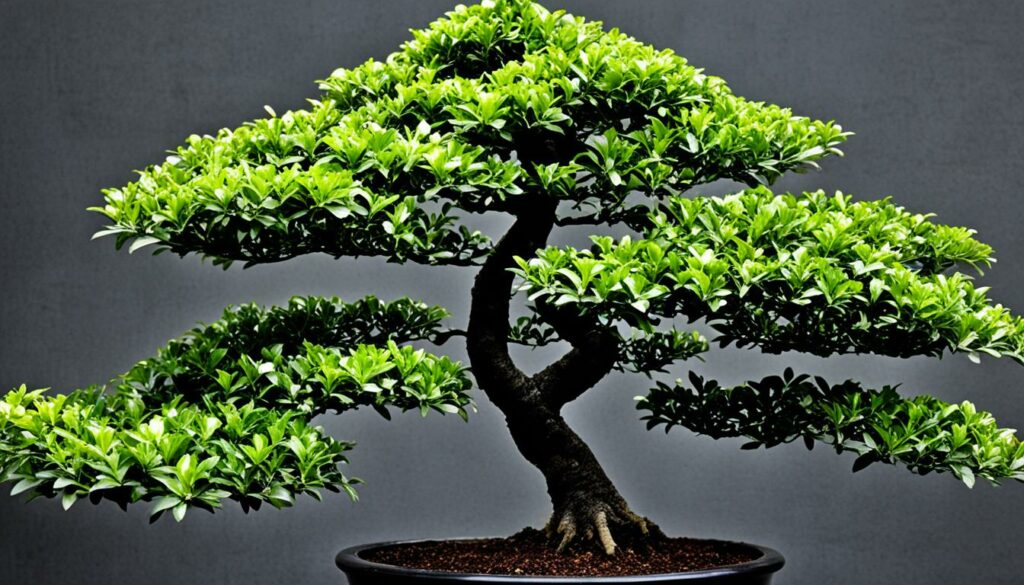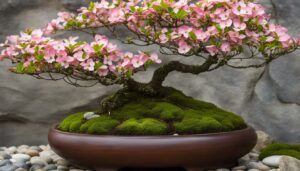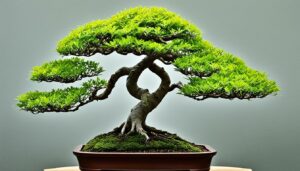If you’re looking for a bonsai tree species that exudes timeless elegance and tranquility, the Japanese Holly might just be what you need. Scientifically known as Ilex crenata, this evergreen bonsai tree is quite remarkable, with its small, glossy green leaves, delicate white flowers, and beautiful red berries that add a touch of grace to any garden or indoor space.
Whether you’re new to the world of bonsai or an experienced enthusiast, the Japanese Holly bonsai is a popular choice due to its unique features and ease of care. In this long-form article, we’ll explore everything you need to know about this bonsai tree species, from its origins and history to its optimal growing conditions and pruning techniques. By the end of this article, you’ll be equipped with the knowledge and inspiration to cultivate your own stunning Japanese Holly bonsai.
Key Takeaways:
- The Japanese Holly bonsai is an elegant and graceful evergreen bonsai tree that adds charm and beauty to any garden or indoor space.
- Scientifically known as Ilex crenata, the Japanese Holly bonsai is a popular choice among bonsai enthusiasts due to its ease of care and unique features.
- Throughout this article, we’ll explore everything you need to know about growing, pruning, and displaying your own Japanese Holly bonsai, including its origins and history, care requirements, and styling options.
Introduction to Japanese Holly Bonsai
If you’re looking for a stunning evergreen bonsai that exudes timeless elegance, the Japanese Holly bonsai may be just what you need. The Japanese Holly, scientifically known as Ilex crenata, is a small tree with glossy green leaves and delicate white flowers, followed by beautiful red berries. This lovely bonsai is a popular choice among enthusiasts for its unique characteristics and rich history.
The Japanese Holly bonsai is native to Japan and some regions of East Asia. It has been cultivated for centuries, and its popularity has spread worldwide due to its appealing appearance and symbolism of balance and harmony. Its small leaves and dense growth pattern make it perfect for bonsai making, and with the right care, it can live for more than 100 years.
If you’re planning to cultivate a Japanese Holly bonsai, it’s essential to learn about its care requirements, including sunlight, watering, and soil type. You should also understand the pruning and shaping techniques needed to maintain its shape, and remain mindful of the potential pests and diseases that may affect it.
In the following sections, we’ll discuss in more detail the features, history, and care requirements of Japanese Holly bonsai, providing you with essential information to help you grow and nurture your beautiful holly bonsai.
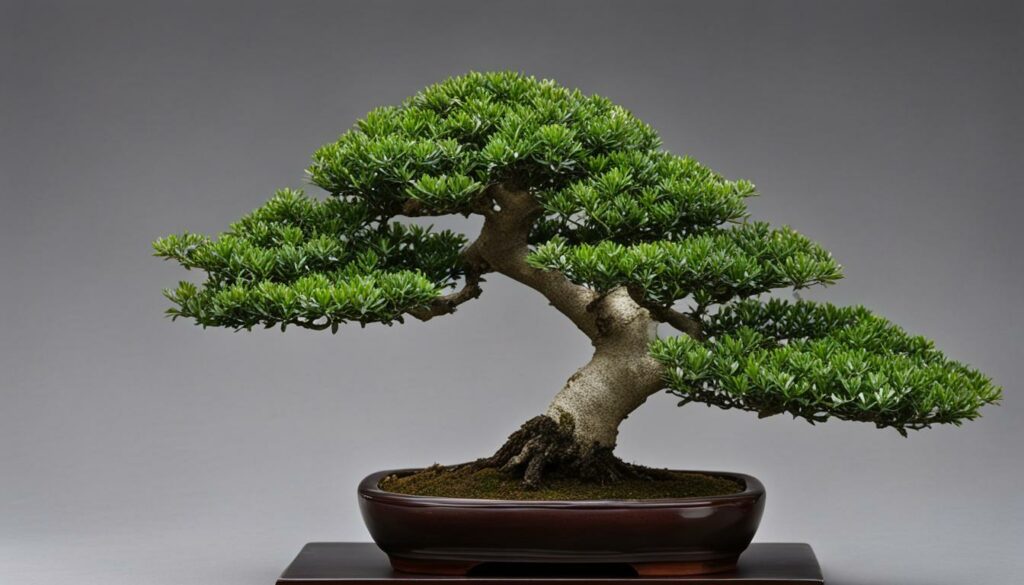
The Graceful Appearance of Japanese Holly
Japanese Holly bonsai is a perfect representation of grace and elegance. Its small, shiny green leaves, measuring about 1/2 inch long, are the true star of the show.
The leaves create a fantastic canopy of dense foliage on the branches, which allows it to respond well to the art of bonsai. The leaves remain on the tree year-round, providing a lush and evergreen presence to your garden or indoor space.
Another striking characteristic of the Japanese Holly bonsai is the delicate white flowers that bloom in the spring, investing your garden with a sense of serenity and tranquility. The flowers also bring a wonderful fragrance.
If you are fortunate, you will also witness the Japanese Holly bonsai producing bright red berries. The berries are usually a shade of red, but the tree can also produce other colors like yellow or orange, depending on the season and conditions.
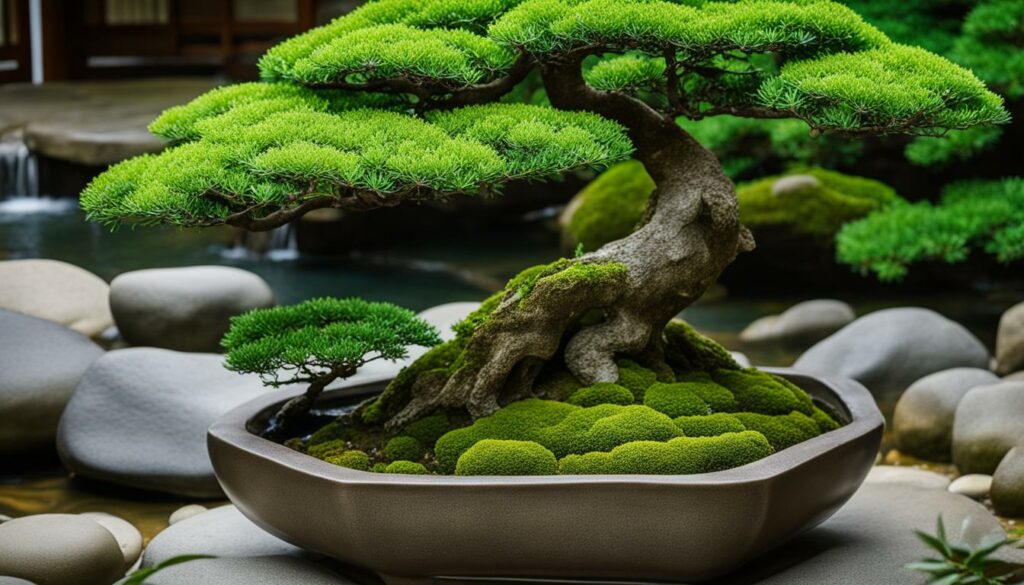
The Japanese Holly bonsai’s unique appearance and charm make it an excellent choice for adding a touch of grace and elegance to your garden. Its evergreen foliage, delicate flowers, and attractive berries are perfect for bringing a tranquil atmosphere to any area of your home.
Understanding the Origins and History
The Japanese Holly bonsai, also known as Ilex crenata, has a rich history dating back to ancient Japan. It is believed that bonsai cultivation in Japan began during the Kamakura period (1185-1333), and the Japanese Holly bonsai was one of the early species selected for cultivation due to its hardiness and resilience to harsh weather conditions.
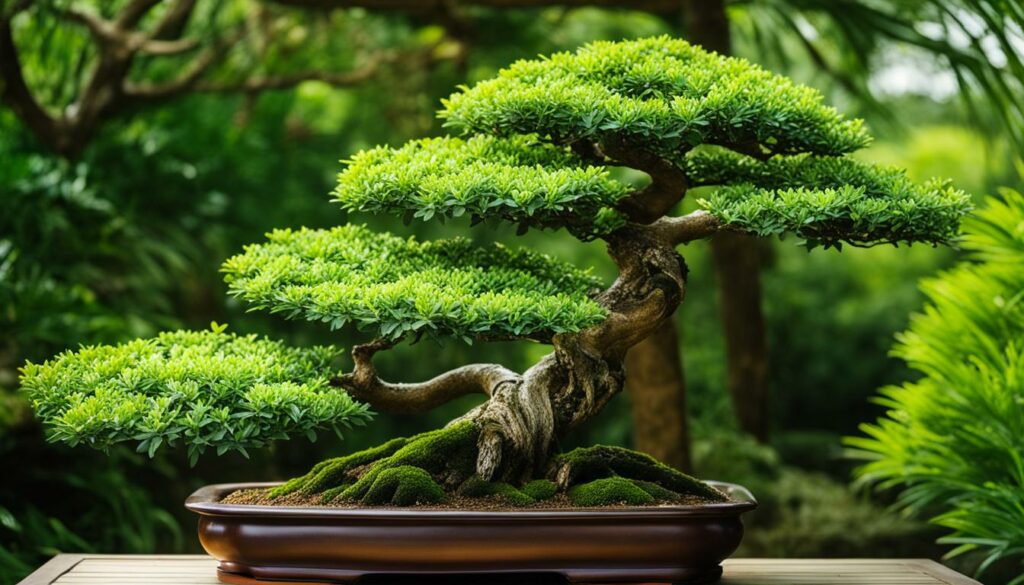
The Japanese Holly bonsai soon became highly prized for its elegant and delicate appearance, with its small leaves and intricate branching patterns. It has since been cultivated extensively throughout Japan and worldwide, with enthusiasts valuing its symbolism of harmony and balance.
One notable characteristic of the Japanese Holly bonsai is its ability to thrive in both indoor and outdoor settings, making it a versatile and popular choice among bonsai lovers. Its abundant foliage, with glossy green leaves and bright red berries, adds to its appeal as an evergreen bonsai.
The Cultural Significance of Japanese Holly Bonsai
The Japanese Holly bonsai has been celebrated in Japanese culture for centuries and holds various meanings and symbolism. In Japan, it is considered a symbol of trust, confidence, and strength. The Japanese Holly bonsai is often given as a gift to express appreciation, gratitude, and well-wishes. It is also a common sight at Japanese tea ceremonies, where its calming and serene presence adds to the meditative atmosphere.
“One of the early species selected for cultivation due to its hardiness and resilience to harsh weather conditions.”
The Impact of Japanese Holly Bonsai on Bonsai Art
The Japanese Holly bonsai has played a significant role in the development of bonsai as an art form. Its small leaves and delicate features make it ideal for creating intricate and detailed bonsai designs. Bonsai artists have experimented with various shapes and styles, including traditional formal upright and informal upright styles, as well as more contemporary designs.
| Bonsai Style | Description |
|---|---|
| Formal Upright | A classic style, with a straight trunk and branches angled upward in a uniform manner |
| Informal Upright | A more naturalistic style, with a curved trunk and branches that alternate in direction |
| Slanting | A dramatic style, with a trunk that slants to one side and branches that sweep upward in a dynamic manner |
| Cascade | A graceful style, with a trunk that cascades downward and branches that trail below the pot |
The Japanese Holly bonsai’s unique characteristics have also contributed to the development of specialized bonsai techniques, such as clip-and-grow and needle-leaf techniques, which allow for precise shaping and grooming of the bonsai.
Growing Conditions for Japanese Holly Bonsai
For your Japanese Holly bonsai to thrive, you need to ensure it gets the right balance of sunlight, temperature, humidity, and water. This section provides you with detailed guidance on the optimal growing conditions to keep your holly bonsai healthy and beautiful.
Sunlight
Japanese Holly bonsai prefers plenty of natural light, but not direct sun exposure all day. During hot summer months, shield your evergreen bonsai from intense sun rays by placing it under partial shade. In colder months, ensure it gets as much sunlight as possible, ideally 4-5 hours of daily sunlight.
Temperature
Ilex crenata thrives in moderate temperatures, with cooler winters and warm summers. Avoid exposing it to extreme temperatures, high winds, or sudden temperature changes. Maintain a consistent temperature range between 15-25°C, and opt for a sheltered spot for your holly bonsai.
Soil Type
The type of soil needed for Japanese Holly bonsai depends on the specific variety and growth stage. Generally, acidic soil with good draining and moisture retention properties is ideal. You can create a perfect soil mixture by combining standard bonsai soil, akadama, and organic matter. Refer to Table 1 below for more detailed information on recommended soil types for different stages of growth.
| Growth Stage | Soil Mixture |
|---|---|
| Early Stages (up to 3 years) | 50% Akadama, 25% Pumice, 25% Organic Matter (peat, bark, etc.) |
| Mid-Late Stages (3-7 years) | 40% Akadama, 40% Pumice, 20% Organic Matter (peat, bark, etc.) |
| Advanced Stages (over 7 years) | 30% Akadama, 50% Pumice, 20% Organic Matter (peat, bark, etc.) |
Watering Techniques
Japanese Holly bonsai requires frequent, but not excessive, watering to keep the soil moist and nourished. Avoid letting the soil dry out completely, as it can harm the roots and affect the health of your holly bonsai. The frequency and amount of watering depend on the season, humidity, and soil type. Refer to Table 2 below for more detailed information on watering techniques and frequency.
| Season | Frequency | Amount of Water |
|---|---|---|
| Spring | Every 2-3 days, depending on humidity | Enough to moisten soil thoroughly, but not excessive |
| Summer | Every day, up to twice a day depending on heat and humidity | Enough to keep soil moist, not let it dry out completely |
| Fall | Every 2-3 days, depending on humidity and temperature | Enough to moisten soil thoroughly, but not excessive |
| Winter | Once a week, depending on soil moisture level | Less frequent watering, enough to avoid total drying out |
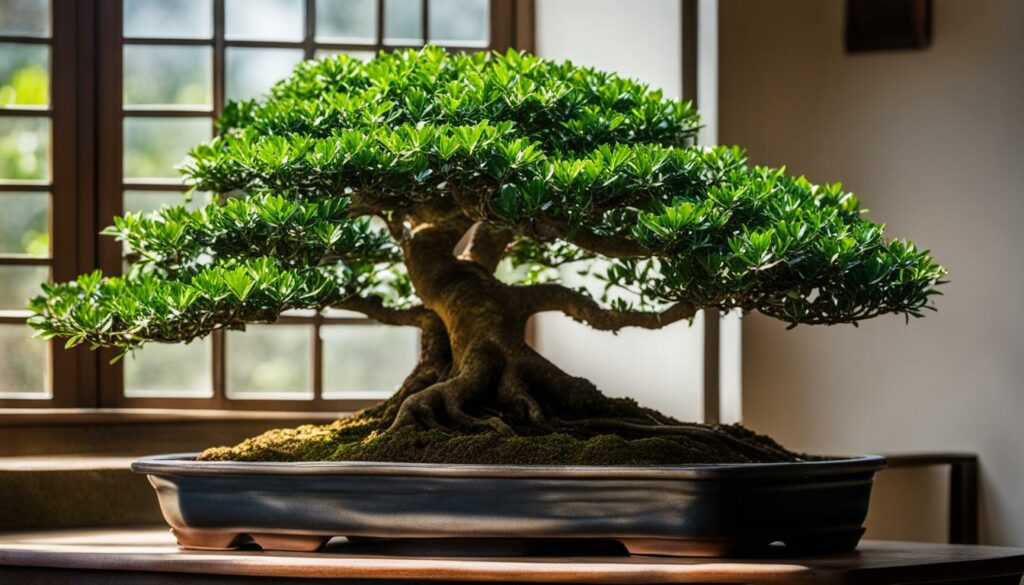
Pruning and Shaping Techniques
Pruning and shaping are crucial for maintaining the health and aesthetics of your Japanese Holly bonsai. By carefully trimming and wiring the tree, you can achieve the desired form, balance, and proportion. Here are some techniques to help:
Step-by-Step Guide to Pruning Japanese Holly Bonsai
1. Identify the branches that need to be removed. Look for branches that are diseased, damaged, or crossing over each other.
2. Use sharp, clean shears to make a clean cut near the base of the branch, avoiding damage to the wood and bark.
3. Prune branches gradually, taking care not to remove more than a third of the foliage at one time.
Wiring Techniques for Japanese Holly Bonsai
Wiring is an essential technique for shaping the branches and trunk of your Japanese Holly bonsai. Here’s how to do it:
1. Choose the right wire. Use aluminum wire that is one-third the diameter of the branch or trunk you want to shape.
2. Wrap the wire around the branch or trunk, starting at the bottom and working your way up. Avoid wrapping it too tightly, as it can damage the tree.
3. Bend the branch or trunk into the desired shape, using the wire to hold it in place. Be careful not to overbend, as it can damage the wood.
4. Leave the wire on for 6-12 months, depending on how fast the Japanese Holly bonsai grows. Remove it before it starts to cut into the bark.
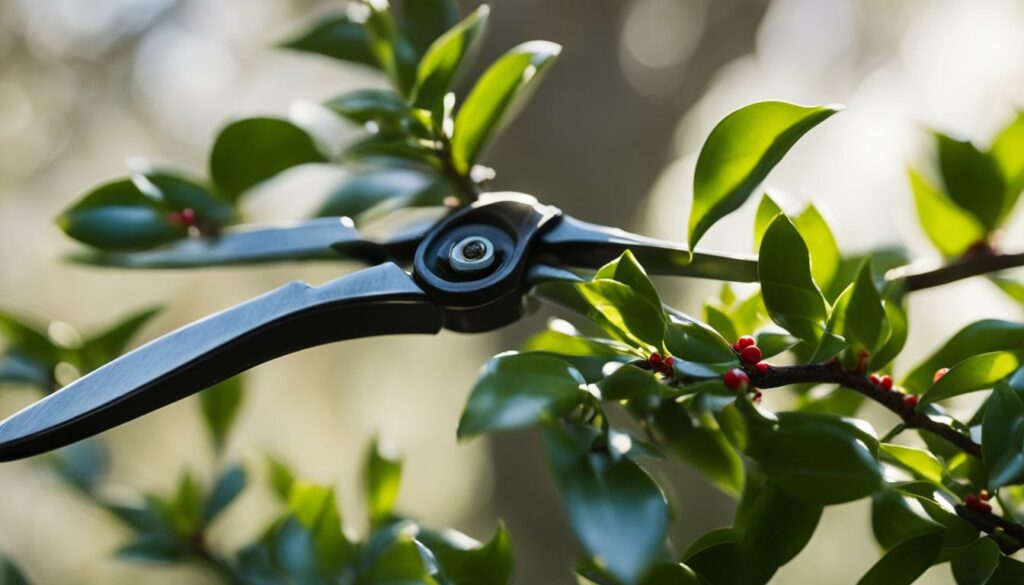
“Pruning and wiring should be done in the fall or early spring, before the growing season begins. This will allow the tree to heal before the next growth spurt.”
These techniques require patience, practice, and precision to achieve the desired results. But with time and effort, you can shape your Japanese Holly bonsai into a stunning piece of living art that will bring beauty and tranquility to your space.
Pests and Diseases to Watch Out For
While the Japanese Holly bonsai is a hardy and resilient species, it is still susceptible to several common pests and diseases that can threaten its health and beauty. By learning how to identify and treat these issues, you can ensure that your holly bonsai stays vibrant and healthy for years to come.
| Pest/Disease | Description | Symptoms | Treatment |
|---|---|---|---|
| Aphids | Tiny insects that cluster on new growth and suck sap from the plant. | Leaves curling, yellowing, and falling off. Sticky residue on leaves. | Spray with insecticidal soap or neem oil. Introduce natural predators like ladybugs. |
| Spider Mites | Tiny arachnids that feed on the sap of the plant and can cause severe damage. | Fine webbing on leaves and stems. Yellow or brown stippling on leaves. Leaves may drop off. | Mist foliage regularly to increase humidity. Spray with insecticidal soap or neem oil. Prune heavily infested leaves and stems. |
| Root Rot | Fungal disease that attacks the roots and can cause the plant to wither and die. | Yellowing leaves that may drop off. Foul odor. Discolored, mushy roots. | Repot the plant in fresh, well-draining soil. Improve drainage and reduce watering. |
| Leaf Spot Fungus | Fungal disease that attacks the leaves and can cause severe defoliation. | Brown or black spots on leaves. Yellowing and dropping off of leaves. Fungal growth on the spots. | Remove infected leaves and dispose of them. Spray with fungicide. Improve air circulation around the plant. |
Regular inspection and maintenance of your Ilex crenata is vital to preventing and treating these common ailments. Keeping your holly bonsai healthy will ensure that it remains a beautiful and elegant addition to your garden or indoor display.
Repotting and Soil Requirements
Repotting your Japanese Holly bonsai tree regularly is crucial to maintain optimal growth and health. However, knowing the right time to repot and the suitable soil mixtures and containers needed are essential to ensure the well-being of your bonsai.
The best time to repot your Japanese Holly bonsai is during its growth period in late winter or early spring. This period allows the tree to recover from the shock of repotting quickly and develop new roots before the new growth period begins.
When selecting the right soil mixture, opt for one that is well-draining, yet water-retentive. A mixture of akadama, pumice, and lava rock, in a ratio of 2:1:1 has proven to be ideal for Japanese Holly bonsais.
Ensure to choose a container that is appropriate to the size of your Japanese Holly bonsai, allowing space for future growth. Consider opting for shallow and wide containers to allow for proper root development and support the growth of your bonsai.
Recommended Soil Mixture for Japanese Holly Bonsai
| Akadama | Pumice | Lava Rock |
|---|---|---|
| 2 parts | 1 part | 1 part |
Pro Tip: Remember to trim the roots of your Japanese Holly bonsai tree lightly to maintain its size and encourage healthy growth. Avoid trimming more than one-third of the roots to avoid stressing your bonsai.
Seasonal Care and Maintenance
Now that you have your Japanese Holly bonsai, it’s important to take good care of it. Bonsai trees require regular maintenance to ensure their health and longevity. Here are some seasonal care tips for your holly bonsai:
Spring
Spring is the perfect time to fertilize your Japanese Holly bonsai. Use a slow-release fertilizer to provide nutrients throughout the growing season. It’s also important to check the soil moisture levels and increase watering as needed with warmer weather.
Summer
During the hot summer months, it’s important to protect your holly bonsai from extreme temperatures. Consider shade cloth or misting to prevent it from drying out. Water more often as the heat evaporates the moisture faster and may cause the soil to dry out.
Fall
In the fall, it’s time to prepare your Japanese Holly bonsai for winter. Reduce the watering frequency but do not let the soil to completely dry out. Gradually decrease fertilization as well. Make sure the bonsai is located in a protected spot out of the wind and be prepared with insulation materials, like mulch, to wrap around the pot to protect the roots during freezing weather.
Winter
During winter, your evergreen bonsai tree will enter dormancy. It is important to keep your Japanese Holly bonsai in a cold but frost-free area, such as a garage or basement where the temperature is around 35-45°F. The light should be low, but the tree still requires light to survive. Water should be kept to a minimum, add water only when the soil is dry to the touch.
By following these simple care tips, your Japanese Holly bonsai will thrive year-round, bringing you joy and beauty for seasons to come.
Styling Options and Displaying Your Japanese Holly
Japanese Holly bonsai trees are known for their elegance and grace, and styling options can help you enhance their natural beauty. There are several display techniques to choose from, including:
- Formal upright: This style displays the tree in a straight, upright position and is recommended for trees with a strong, central trunk. It’s a popular style for Japanese Holly bonsai.
- Informal upright: This style allows for a more natural appearance, with the trunk curving slightly to one side. It’s perfect for trees with slightly bent or twisted trunks.
- Slanting: This style displays the tree at an angle, creating a sense of movement and drama. It’s a great option if you want to showcase the unique shape of your bonsai.
- Cascade: This style is perfect for trees with longer branches that droop downward, creating a “waterfall” effect. It’s a stunning display option for Japanese Holly bonsai.
Experiment with different styles to find the one that best suits your Japanese Holly bonsai tree. Don’t be afraid to get creative and try new things.
When it comes to displaying your Japanese Holly bonsai, there are a few key things to keep in mind. First, make sure it’s in a spot with good natural light, but not in direct sunlight. Second, consider the aesthetic of the space around it. Pairing your bonsai with complementary colors and textures can help it stand out.
Finally, consider the container you use to display your bonsai. The right container can enhance its beauty and complement its style. For example, a simple, understated container works well for a formal upright style, while a more ornate, decorative container can add to the drama of a slanting or cascade style.
Japanese Holly Bonsai in Gardens and Indoors
If you’re considering adding a Japanese Holly bonsai to your home or garden, it’s essential to understand the suitability of this evergreen bonsai for both indoor and outdoor environments.
Japanese Holly bonsai is a great option for outdoor gardens, providing year-round beauty with its glossy green leaves and vibrant red berries. It’s important to choose a strategically placed area with adequate sunlight and protection from harsh winter winds. Make sure you select a pot or container that accommodates growth and has proper drainage.
On the other hand, Japanese Holly bonsai also thrives in indoor spaces, adding elegance and a sense of tranquility to your home or office. Place your bonsai near a window that allows for natural light and avoid areas with extreme temperatures. Remember to frequently check for adequate moisture levels and repot your bonsai when necessary.
Whether you choose to display your Japanese Holly bonsai in a garden or indoor setting, it’s essential to understand its care requirements in each environment.
Conclusion
You have learned the beauty and grace of the Japanese Holly bonsai, also known as Ilex crenata. This evergreen bonsai species can add tranquility and timeless elegance to your garden or indoor space.
By understanding the optimal growing conditions, pruning techniques, and suitable soil requirements, you can successfully cultivate and enjoy the grace of this holly bonsai for years to come.
Whether you choose to display your Japanese Holly bonsai using various styling options or integrate it into your existing garden, its striking appearance and rich history make it a remarkable addition to any setting.
Remember to practice seasonal care and maintenance techniques, protect it from common pests and diseases, and repot it as needed. With proper care and attention, you can showcase the beauty of this evergreen bonsai and create a peaceful environment in your home or garden.
FAQ
What is a Japanese Holly bonsai?
A Japanese Holly bonsai is a small version of the Ilex crenata, an evergreen bonsai tree native to Japan. It is known for its elegant appearance, with small glossy green leaves, delicate white flowers, and beautiful red berries.
How do I care for a Japanese Holly bonsai?
To care for a Japanese Holly bonsai, you need to provide it with the optimal growing conditions. This includes placing it in a location with ample sunlight, maintaining the right temperature and humidity levels, using well-draining soil, and watering it correctly. Regular pruning and shaping are also essential for maintaining its form and balance.
Can I grow a Japanese Holly bonsai indoors?
Yes, you can grow a Japanese Holly bonsai indoors. However, it requires proper care and attention to ensure its health and vitality. It is important to place it near a window where it can receive sufficient sunlight, maintain the right temperature and humidity levels, and provide proper watering and fertilization.
How often should I repot my Japanese Holly bonsai?
Japanese Holly bonsai should be repotted approximately every two to three years, depending on its growth. The best time to repot is in the early spring before new growth appears. When repotting, carefully prune the roots and place the bonsai in fresh, well-draining soil to promote healthy growth.
What pests and diseases should I watch out for with my Japanese Holly bonsai?
Some common pests that can affect your Japanese Holly bonsai include aphids, spider mites, and scale insects. Additionally, it can be susceptible to diseases such as root rot and leaf spot fungus. Regular inspection and proper preventive measures, such as proper watering and good ventilation, can help minimize the risk of infestations and diseases.
Can I shape my Japanese Holly bonsai into different styles?
Yes, you can shape your Japanese Holly bonsai into various styles, including formal upright, informal upright, slanting, and cascade styles. Each style has its own unique characteristics and requires specific pruning and wiring techniques. It is important to study and understand the desired style before attempting to shape your bonsai.
How can I integrate my Japanese Holly bonsai into my garden?
You can integrate your Japanese Holly bonsai into your garden by selecting a suitable location that provides the right amount of sunlight and protection from harsh weather conditions. Consider the overall design and style of your garden to ensure that the bonsai complements the existing plants and landscape. Regular care and maintenance, such as proper watering and fertilization, will help it thrive in its new environment.
What is the significance of Japanese Holly bonsai in Japanese culture?
Japanese Holly bonsai holds great cultural significance in Japan as a symbol of harmony and balance. It is often associated with the Zen philosophy and is appreciated for its elegant and timeless beauty. The art of cultivating and caring for bonsai is deeply rooted in Japanese culture and has been practiced for centuries.
